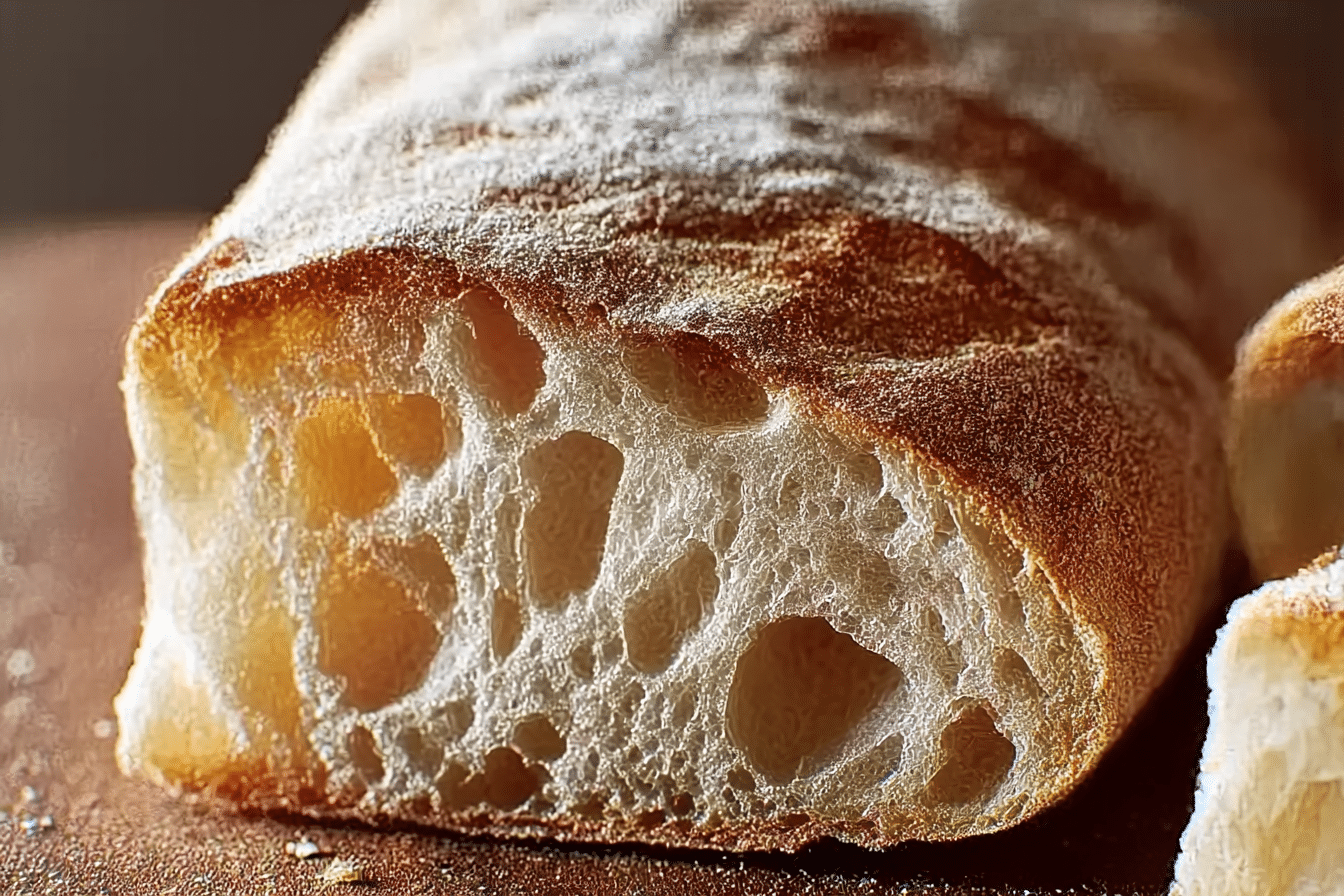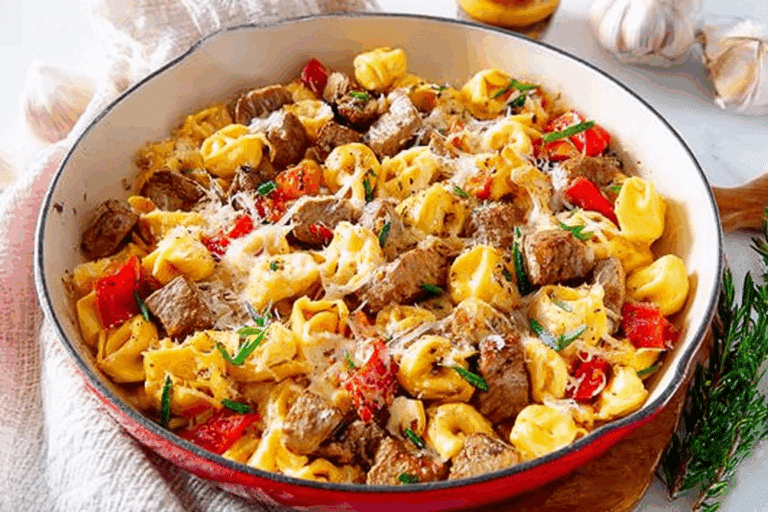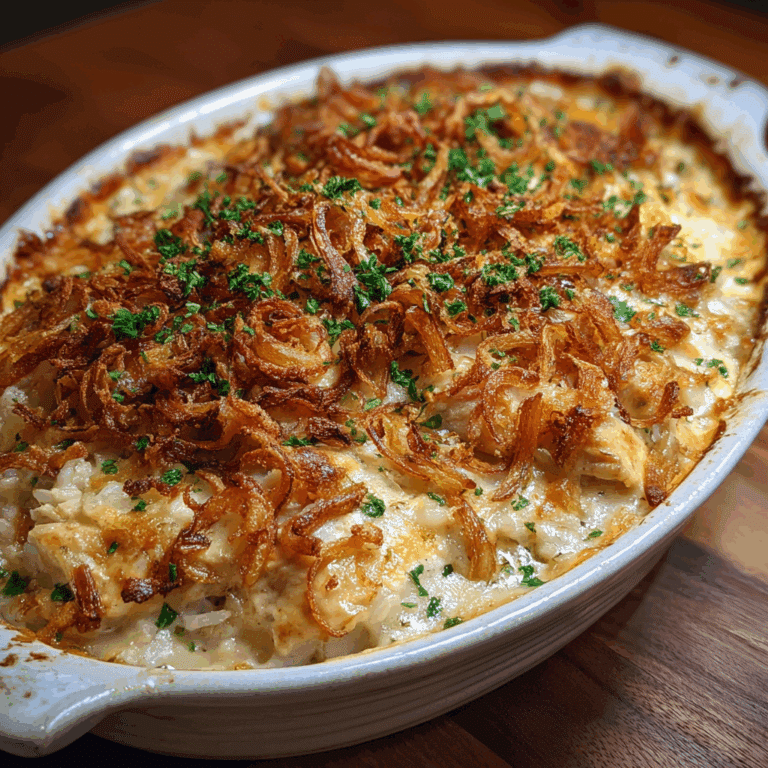Italian Ciabatta Bread
There’s something undeniably magical about the smell of fresh bread wafting through the kitchen, especially when it’s warm, crusty Italian ciabatta. That golden, crackling crust giving way to a chewy, airy crumb—it’s the kind of experience that makes you close your eyes and just savor. Trust me, you’re going to love this rustic beauty. It’s more than just bread, it’s a love letter to simplicity, texture, and timeless flavor.
Behind the Recipe
The first time I made ciabatta, I was chasing a memory—a memory of a tiny café in Florence, where the bread was as airy as a cloud yet hearty enough to cradle fresh mozzarella and sun-dried tomatoes. I remember biting into that sandwich and marveling at the contrast between the crisp crust and pillowy interior. That texture, that flavor, haunted me in the best way. So I went on a mission to recreate it in my own kitchen—and now I get to share it with you.
Recipe Origin or Trivia
Ciabatta, meaning “slipper” in Italian, is aptly named for its flat, oval shape that somewhat resembles—you guessed it—a slipper. It was born in 1982 in the Veneto region of Italy as a response to the French baguette. While baguettes were dominating sandwich culture, Italian bakers wanted to offer something uniquely their own. Thus, ciabatta emerged, bringing with it an open crumb structure and a slightly tangy, fermented taste that pairs perfectly with everything from olive oil to roasted vegetables.
Why You’ll Love Italian Ciabatta Bread
Every slice of ciabatta is a testament to the beauty of bread-making. Here’s why it deserves a place in your baking rotation:
Versatile: Whether you’re making sandwiches, toasting it with garlic butter, or using it to mop up sauces, ciabatta can do it all.
Budget-Friendly: With just a few pantry staples, you can create something that feels gourmet.
Quick and Easy: The process is simple and mostly hands-off—just a bit of patience required.
Customizable: Infuse it with rosemary, olives, or sun-dried tomatoes for fun twists.
Crowd-Pleasing: That crunch and chew combo wins over everyone, every time.
Make-Ahead Friendly: The dough can be refrigerated overnight to develop deeper flavor.
Great for Leftovers: Toasted, grilled, or turned into croutons—it never goes to waste.
Chef’s Pro Tips for Perfect Results
To capture the essence of authentic ciabatta, here are a few tried-and-true tips:
- Use a high hydration dough to achieve the classic open crumb structure. It’ll be sticky—embrace it.
- Don’t overwork the dough. Gentle folding helps develop structure without killing the air pockets.
- Use a bench scraper to help you handle the sticky dough instead of adding extra flour.
- Let it ferment overnight in the fridge for a deeper, tangier flavor.
- Bake with steam by adding a pan of water to your oven—this helps create that iconic crust.
Kitchen Tools You’ll Need
Before we get messy with flour, here’s what you’ll want on hand:
Mixing Bowl: For combining and fermenting your dough.
Bench Scraper: Helps manage sticky dough without deflating it.
Parchment Paper: Prevents sticking during the final bake.
Baking Stone or Steel: Helps achieve that artisan crust from home ovens.
Proofing Container or Lid: Keeps your dough covered and moist during rise time.
Ingredients in Italian Ciabatta Bread
The beauty of ciabatta lies in its simplicity. Each ingredient plays its part like a note in a perfect melody:
- Bread Flour: 500 grams (about 4 cups) – High protein helps build gluten for structure and chew.
- Water: 400 grams (1 ¾ cups) – Hydrates the flour and supports fermentation, leading to an airy crumb.
- Instant Yeast: 1 teaspoon – Kicks off the fermentation, lifting the dough without long proof times.
- Salt: 10 grams (2 teaspoons) – Balances flavor and strengthens gluten structure.
- Olive Oil (optional): 1 tablespoon – Adds a touch of richness and softness to the crumb.
Ingredient Substitutions
Life happens—here are a few flexible swaps to keep things rolling:
Bread Flour: All-purpose flour (expect slightly less chew).
Instant Yeast: Active dry yeast (proof in warm water before using).
Olive Oil: Melted butter (if you want a richer taste).
Ingredient Spotlight
Bread Flour: With its higher protein content, bread flour is key to ciabatta’s open crumb and chewy texture.
Water: More than just hydration—water activates gluten and helps yeast thrive.
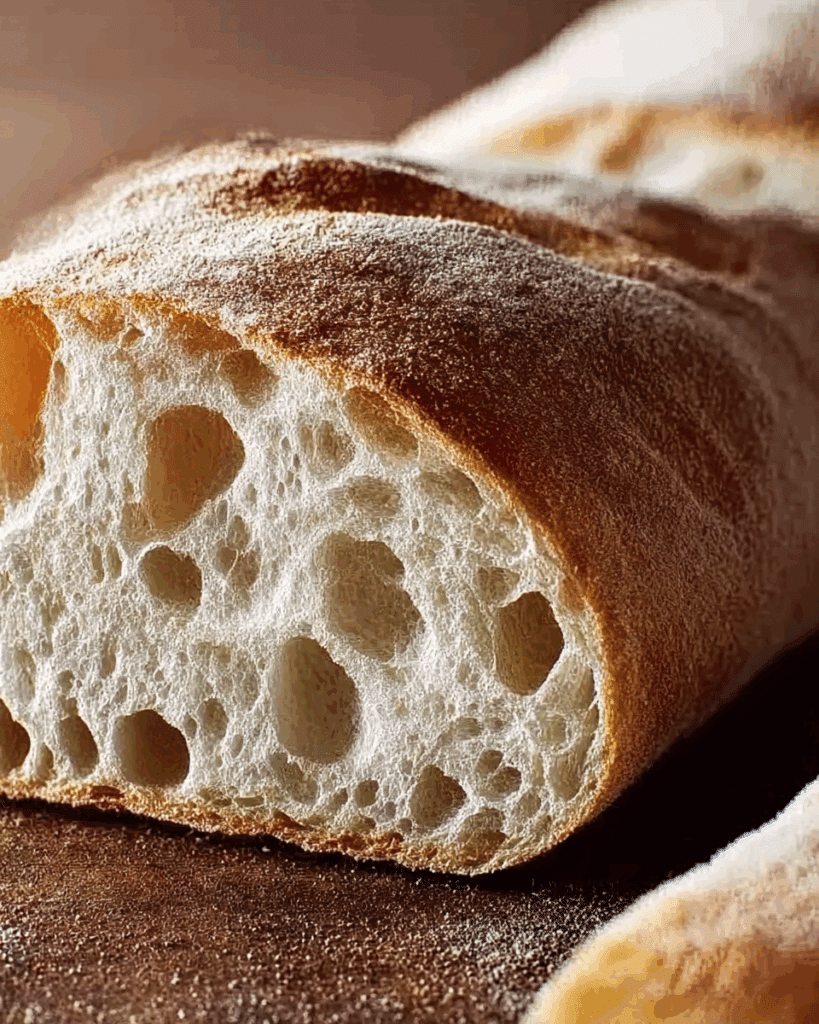
Instructions for Making Italian Ciabatta Bread
Let’s roll up our sleeves and bring some doughy magic to life. Here are the steps you’re going to follow:
-
Preheat Your Equipment:
If using a baking stone, place it in the oven and preheat to 475°F (245°C) at least 30 minutes before baking. -
Combine Ingredients:
In a large bowl, mix bread flour, salt, and yeast. Add water gradually, stirring until a sticky dough forms. -
Prepare Your Cooking Vessel:
Line a baking sheet with parchment paper and dust with flour. -
Assemble the Dish:
After the dough rests for 1 hour, perform 3 sets of stretch-and-folds every 30 minutes. Then, transfer it to the floured parchment, divide gently into two loaves. -
Cook to Perfection:
Slide the parchment with loaves onto your preheated stone or baking sheet. Bake 20–25 minutes until golden brown and hollow-sounding when tapped. -
Finishing Touches:
Cool on a wire rack for at least 30 minutes to set the structure and crust. -
Serve and Enjoy:
Slice, tear, dip, or stack—however you enjoy it, ciabatta always delivers.
Texture & Flavor Secrets
The contrast is everything here. That outer crust? Golden, crunchy, and audibly satisfying. Inside, it’s all about air—light, fluffy, with a subtle tang from slow fermentation. It’s rustic and refined all at once, perfect for sandwiches or simple olive oil dips.
Cooking Tips & Tricks
These little nudges make all the difference:
- Use wet hands when handling the dough to reduce sticking.
- For better crust, bake with a pan of boiling water in the oven to create steam.
- A long ferment (even overnight) deepens the flavor and improves texture.
What to Avoid
Let’s dodge these common bread blunders:
- Don’t add too much flour—it’s supposed to be sticky.
- Avoid overproofing, which can flatten the dough and ruin the rise.
- Don’t skip steam in the oven—that crust needs it.
Nutrition Facts
Servings: 10
Calories per serving: 165
Note: These are approximate values.
Preparation Time
Prep Time: 15 minutes (plus resting/fermenting time)
Cook Time: 25 minutes
Total Time: 4 hours (including rising)
Make-Ahead and Storage Tips
The dough can be prepared the night before and stored in the fridge for a slow ferment. Once baked, ciabatta keeps well at room temperature for 2 days. Wrap it in a towel or paper bag. For longer storage, freeze slices and reheat in the oven to revive the crust.
How to Serve Italian Ciabatta Bread
Pair it with herbed olive oil, stack it with grilled vegetables, make it the base for paninis, or turn it into garlic bread. It’s a blank canvas with endless delicious potential.
Creative Leftover Transformations
Turn stale slices into:
- Rustic croutons for salads or soups
- Bread pudding with a savory twist
- Crispy crostini topped with tomatoes and basil
Additional Tips
- Dust your counter with rice flour to prevent sticking without toughening the dough.
- Want extra flavor? Add chopped olives or sun-dried tomatoes before the final fold.
- For an artisan look, flour the top before baking for that rustic bakery finish.
Make It a Showstopper
Shape each loaf with care and bake until deeply golden. Let those open crumb holes shine when sliced. Present on a wooden board with olive oil and flaky sea salt—it’s simple, elegant, and irresistible.
Variations to Try
- Rosemary Ciabatta: Add 1 tablespoon chopped fresh rosemary to the dough.
- Whole Wheat Ciabatta: Swap 100 grams of bread flour for whole wheat flour.
- Garlic Ciabatta: Mix in 1 teaspoon garlic powder for a subtle aromatic twist.
- Ciabatta Rolls: Divide into smaller portions and shape into individual buns.
- Seeded Ciabatta: Roll dough in sesame or poppy seeds before baking.
FAQ’s
Q1: Can I make ciabatta without a baking stone?
A1: Yes, a preheated baking sheet will also work—just make sure it’s hot before placing your dough on it.
Q2: Why is my dough so sticky?
A2: Ciabatta dough has high hydration, which gives it that airy crumb. Sticky is good—resist the urge to over-flour.
Q3: How do I know when it’s done baking?
A3: The crust should be golden and the loaf should sound hollow when tapped on the bottom.
Q4: Can I freeze the dough?
A4: Absolutely. After the first rise, shape and freeze. Thaw overnight in the fridge before baking.
Q5: Why didn’t my bread rise well?
A5: It could be over-proofed or your yeast might be expired. Make sure your dough still feels elastic before baking.
Q6: Can I use sourdough starter instead of yeast?
A6: Yes, just adjust hydration and fermentation time accordingly.
Q7: How do I store it to keep it crispy?
A7: Keep it in a paper bag at room temp. Plastic traps moisture and softens the crust.
Q8: Can I add herbs or cheese?
A8: Definitely—just fold them in gently during the final stretch.
Q9: Why do I need steam in the oven?
A9: Steam helps create that iconic crust by delaying the formation of the crust during baking.
Q10: What’s the best flour to use?
A10: Bread flour is ideal for structure and chew, but you can blend with all-purpose if needed.
Conclusion
Ciabatta bread isn’t just another loaf—it’s an experience. From the satisfying crack of the crust to the tender, airy interior, it’s a journey worth every minute of effort. Whether you’re making a sandwich or simply dipping it in olive oil, this bread brings a bit of Italian soul to your table. Now it’s your turn—get that flour flying and bake something unforgettable.
Print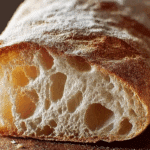
Italian Ciabatta Bread
- Prep Time: 15 minutes (plus resting/fermenting time)
- Cook Time: 25 minutes
- Total Time: 4 hours (including rising)
- Yield: 2 loaves (10 servings total)
- Category: Bread
- Method: Baking
- Cuisine: Italian
- Diet: Vegetarian
Description
Authentic Italian ciabatta bread with a crisp crust and light, airy interior—perfect for sandwiches or dipping in olive oil.
Ingredients
- Bread Flour: 500 grams (about 4 cups) – High protein helps build gluten for structure and chew.
- Water: 400 grams (1 ¾ cups) – Hydrates the flour and supports fermentation, leading to an airy crumb.
- Instant Yeast: 1 teaspoon – Kicks off the fermentation, lifting the dough without long proof times.
- Salt: 10 grams (2 teaspoons) – Balances flavor and strengthens gluten structure.
- Olive Oil (optional): 1 tablespoon – Adds a touch of richness and softness to the crumb.
Instructions
- Preheat Your Equipment: If using a baking stone, place it in the oven and preheat to 475°F (245°C) at least 30 minutes before baking.
- Combine Ingredients: In a large bowl, mix bread flour, salt, and yeast. Add water gradually, stirring until a sticky dough forms.
- Prepare Your Cooking Vessel: Line a baking sheet with parchment paper and dust with flour.
- Assemble the Dish: After the dough rests for 1 hour, perform 3 sets of stretch-and-folds every 30 minutes. Then, transfer it to the floured parchment, divide gently into two loaves.
- Cook to Perfection: Slide the parchment with loaves onto your preheated stone or baking sheet. Bake 20–25 minutes until golden brown and hollow-sounding when tapped.
- Finishing Touches: Cool on a wire rack for at least 30 minutes to set the structure and crust.
- Serve and Enjoy: Slice, tear, dip, or stack—however you enjoy it, ciabatta always delivers.
Notes
- Use a high hydration dough for that airy crumb—don’t be afraid of the stickiness.
- Bake with steam for a golden, crunchy crust.
- Letting the dough ferment overnight deepens the flavor.
Nutrition
- Serving Size: 1 slice
- Calories: 165
- Sugar: 0g
- Sodium: 390mg
- Fat: 2g
- Saturated Fat: 0.3g
- Unsaturated Fat: 1.7g
- Trans Fat: 0g
- Carbohydrates: 32g
- Fiber: 1g
- Protein: 5g
- Cholesterol: 0mg

